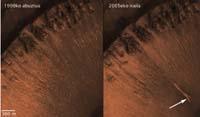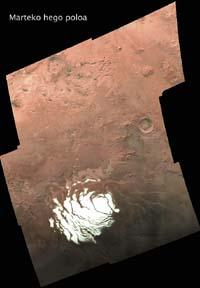Mars, a planet sold in the water

Finally, they find water on Mars... for the sixth time. NASA has spread the discovery with great letters in all the media. But, once again, you have to read the small letter: they have not found water, but a footprint that supposedly has left the water. Two remains at two points on the surface of Mars. The photographs of these two sites were taken in 1999 and 2001 and were repeated in 2004 and 2005. In the last two photographs, there is a detachment of sand in places where it did not exist, four years earlier, and NASA astronomers have concluded that these landslides have been caused by a water leak.
That is, they have found water without finding water.
It is not the first time. In many other occasions the news of the presence of water, based on geological and chemical traces that are not the same, has spread. They talk about water, but without finding water.

In recent years they have been based on three discoveries to say that there is water on Mars. On the one hand, in 2001, the Mars Oddisey probe detected hydrogen atoms in the Martian south pole. They are not independent hydrogen atoms, but are part of molecules. But what molecules? According to NASA, the water molecule was the main candidate. "As there is hydrogen," he said, "there must be water."
On the other hand, carbonates were found. Carbonates are not formed if not by water action, so the mere presence of carbonates indicated the presence of water on Mars. But the number of carbonates was very small; from the orbit around the planet, the mineral was detected by NASA's Mars Global Surveyor and ESA's Mars Express probes, but only sulphates were found on the planet's surface. It was then explained that sulfates prevent the formation of carbonates. "The presence of sulphates and carbonates has been, as they indicated, on some occasion present on Mars."
Finally, more clues have been found in the photos: On the Martian surface there have been numerous geological phenomena caused by the dry and liquid basin of the streams, among which are the current sand landslides. And what is the liquid that has produced it? NASA believes it should be water.
Not all astronomers agree; it can also be liquid carbon dioxide, or the sand has fallen on the slope. But water, despite being a good scientific option, offers something else: advertising. Where there is water you can create life. Yes, if the water is in a liquid state.

However, they have not found liquid water. It is logical because, on the one hand, Mars is far from the Sun and on the other, it is small. Far away, the night of Mars has a very low temperature, capable of completely freezing liquid water. Due to its small size, its gravity is low and does not maintain numerous gas molecules in its environment, that is, its atmosphere is very thin, so its atmospheric pressure is very low. If the atmosphere does not exert pressure, water evaporates at the clear day temperature of Mars. Therefore they have not found liquid water, but if there is water it is in solid or gaseous state, not in liquid state.
Perhaps it has not always been so. Perhaps, when the planet emerged it would have had a more compact atmosphere. The liquid water of yesteryear may be buried. And perhaps frozen. However, NASA and ESA have not found water on Mars.





